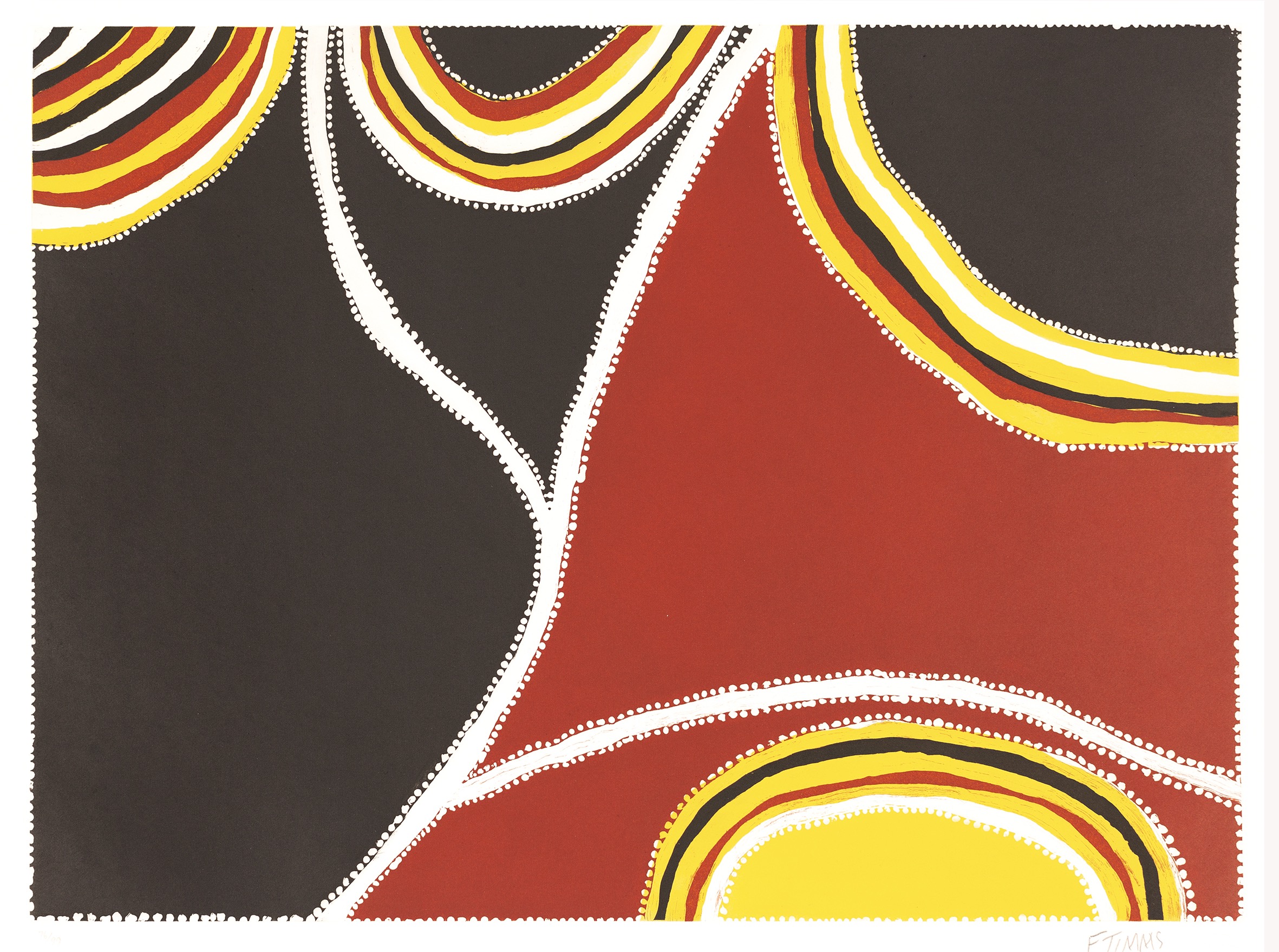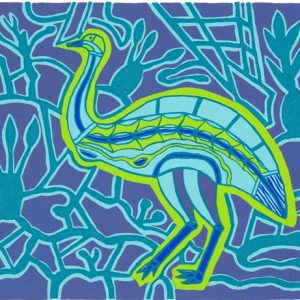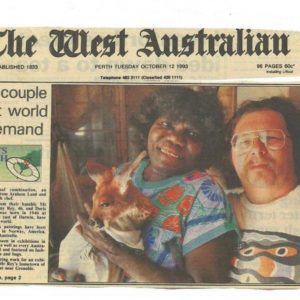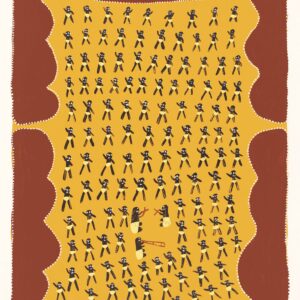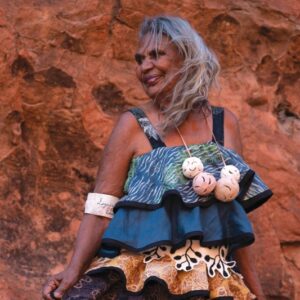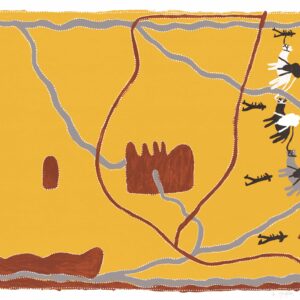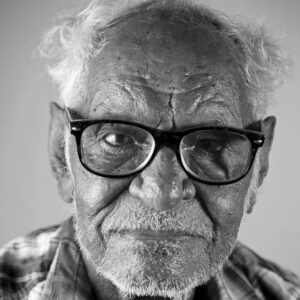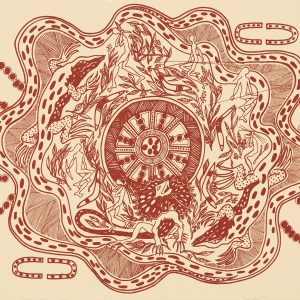Description
Details
- Type: Etching (multi-plate)
- Edition: 99
- Paper: Hahnemuhle 350gsm
- Size: 450 x 605 (image) and 630 x 790 mm
- Printer: Basil Hall, Basil Hall Editions Darwin, NT, 2002
Story
The Bungle Bungle Range in Purnululu National Park, located in the East Kimberleys, is one of the most extraordinary geological landmarks in Western Australia. Around Piccaninny Gorge the range is cut by deep gullies and breaks up into areas of ridges and beehive shaped domes with distinctive orange and black or grey bands. These bands are made up of sandstones and conglomerates (rocks composed of pebbles and boulders) that have been cemented together over time. In Gija, the Aboriginal language of the area, Purnululu means sandstone. The name Bungle Bungle is either a corruption of an Aboriginal name for the area or a misspelling of one of the common Kimberley grasses found here, bundle bundle grass. Piccaninny Creek dissects these famous structures and drains the area from the torrential downpours forming the hundred metre deep, slab-sided gorge as it cuts through the sandstone. Freddy’s unique view depicts the multi coloured outcrops, and the creek, as it enters the gorge.
Artist Biography: Freddie (Freddy) Timms
Lived: 1944 – 2017
Language group: Gija
Freddie Timms (Ngarrmaliny Janama) was born at Police Hole, Bedford Station Downs in 1944. Growing up on the busy property he learned all the necessary riding and stock handling skills at an early age. He contract mustered on most of them surrounding pastoral leases, including Bedford, Bow River, Lissadell, Mabel Downs, Old Argyle and Texas Downs. After the stockmen’s dispute in the seventies, which resulted in the removal of most of the people from their homelands, he was placed first in the Guda-Guda Community at Wyndham, after which he and his family were relocated to Warmun/Turkey Creek.
When he was living at Frog Hollow, south of Turkey Creek in the 1980s, Joel Smoker of Waringarri Arts brought canvases to Jack Britten, Rover Thomas, Hector Jandany and his father-in-law, George Mung-Mung. Timms asked for canvases as well and painted passionately. He painted in a style reminiscent of Thomas but recognisably his own, with expanses of paint lined with white dots. Many of his pictures are like aerial maps of the bones of the country where he lived and worked all his life. Mapping is on a topographic level showing features of the landscape such as black soil, red ground, sandy ground, hills, creeks and water holes as well as a historical and spiritual level, showing roads, stockyards, homesteads and dreaming places. Much of the country where he worked on Lissadell, a frequent painting subject, is now under the water of Lake Argyle formed by the damming of the Ord River.
Freddie Timms is one of the few Aboriginal artists from a traditional background who, on occasion, made an evident political statement in his work. He began exhibiting at Watters Gallery through an introduction from Tony Oliver, who he met in Melbourne. Later, he and Oliver set up a corporation (now Jirrawun Arts), to market work on a consignment basis for an increasingly wide group of Kimberley artists, including Paddy Bedford, Rusty Peters, Churchill Cann, Goody Barrett, Phyllis Thomas and his father’s brother Timmy Timms. He also helped initiate the Neminuwarlin Performance group with his aunt and lead singer and dancer Peggy Patrick.
Before the artist passed away in March 2017, he and wife Beryline, lived at the tiny community of Frog Hollow where he enjoyed the peace and quiet painting his stories. He started painting in the 1980s, using the knowledge and techniques that he had acquired by working and talking with, the other stockmen/artists such as Jack Britten, Hector Jandanay, Henry Wambini, the late Rover Thomas and his father-in-law, Paddy Jampinji, who was one of the finest of the earlier Warmun/Turkey Creek artists.
Collections
National Gallery of Australia, Canberra
National Gallery of Victoria, Melbourne
Art Gallery of Western Australia, Perth
Art Gallery of South Australia, Adelaide
Art Gallery of New South Wales, Sydney
Aboriginal Art Museum, Utrecht, The NetherlandsThe Kelton Foundation, Santa Monica, U.S.A.
Group Exhibitions
1989, Turkey Creek: Recent Work, Deutscher Gertrude Street, Melbourne
1990, The Seventh National Aboriginal Art Award Exhibition, Museum and Art Gallery of the Northern Territory, Darwin
1991, The Eighth National Aboriginal Art Award Exhibition, Museum and Art Gallery of the Northern Territory, Darwin
1992, The Ninth National Aboriginal Art Award Exhibition, Museum and Art Gallery of the Northern Territory, Darwin
1993, Images of Power, Aboriginal Art of the Kimberley, National Gallery of Victoria, Melbourne
1993/4, ARATJARA, Art of the First Australians, Touring: Kunstammlung Nordrhein-Westfalen, Dusseldorf
Hayward Gallery, London; Louisiana Museum, Humlebaek, Denmark
Bibliography
Ryan, J., 1993, Images of Power, Aboriginal Art of the Kimberley, exhib, cat., National Gallery of Victoria, Melbourne
1993, Aratjara, Art of the First Australians: Traditional and Contemporary Works by Aboriginal and Torres Strait Islander Artists, exhib. cat. (conceived and designed by Bernard Luthi in collaboration with Gary Lee), Dumont, Buchverlag, Koln. (C)

